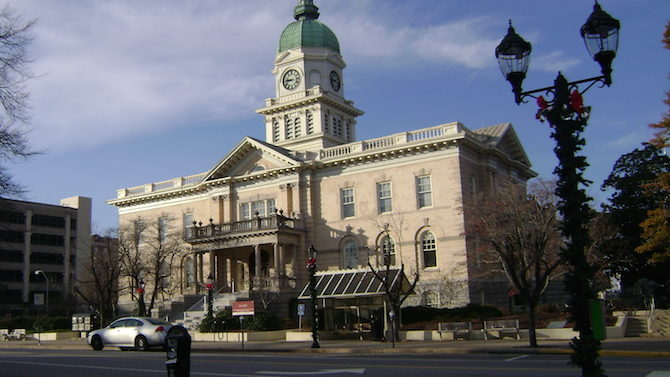Athens-Clarke property owners would pay a separate fee on tax bills to fund streetlights under a proposal by the Transportation and Public Works Department, which currently spends a quarter of its budget on streetlight costs.
Streetlights are not owned by the government, but by Georgia Power or an EMC, which charge the government to power and maintain them. Those rates are set by the state Public Service Commission, and although Georgia Power has been replacing its old-style streetlights with more efficient LEDs, the utility has not reduced its charges to local government—nor is it likely to, according to a 2016 AJC article saying that Georgia Power has no motivation to lower costs to cities, nor to provide innovative streetlights that can change color, dim in the wee hours or be brightened by police when needed. At a work session last week, commissioners asked for more information about the possibility of ACC owning its own streetlights.
They were also surprised to learn that Georgia Power had been charging ACC for about a dozen streetlights that turned out to be located in downtown Atlanta—and “we’re continuing to ask for” a refund, according to Stephen Bailey of TPW. ACC’s 7,700 streetlights cost the county nearly $1 million a year.
Property owners would pay about $14 per land parcel each year for general street lighting in the county, which is mostly focused on road safety, plus about $26 if the parcel is also served by a nearby street light. “You could actually charge based on each person’s lighting benefits,” Bailey said. At present there are some 20 outstanding requests for new streetlights, but no budget to cover them.
A number of Georgia cities and counties already charge separately for streetlights. Implementing the charges would enable ACC to hire someone to more closely monitor streetlight bills and requests, plus a second person to administer the billing program. Most commissioners seemed open to the proposal, but others advised caution—especially since the county’s stormwater fees have been controversial.
“I think we’re opening up a tremendous Pandora’s box here,” said Commissioner Jerry NeSmith. “To charge somebody a dollar a month for streetlights when they don’t have any will make the stormwater confusion look easy.”
Through innovations like piping methane from rotting underground areas of the landfill and installing solar arrays, ACC’s government produces electricity equivalent to 15% of its entire energy consumption, Sustainability Officer Andrew Saunders told commissioners at the May 14 work session. The county has committed to relying less on unsustainable energy sources, and “solar is becoming the most cost-competitive,” he said. Solar arrays have been installed at the Multimodal Center, the jail, the Streets and Drainage facility on Spring Valley Road and an extensive one at the Cedar Creek sewage treatment plant.
Harvesting energy locally not only reduces greenhouse gases, Saunders said, but keeps jobs and money in Athens, and can reduce the cost burden on households who may have to choose between paying for heat or paying for rent or food. “This community is sending an awful lot of dollars out of the community for energy,” Saunders said. Mayor Kelly Girtz has signed the Sierra Club pledge to “aim for” wholly sustainable energy sources. But the most efficient way to sustainability is not through generating energy, but by reducing energy use, Saunders said. “It’s much more cost-effective.”
Half of county government’s energy consumption is electricity; the rest is mostly gasoline and diesel. And three-fourths of that electricity goes for one purpose: sewage treatment. A $1 million, 5-acre solar array at the Cedar Creek treatment plant covers half of that facility’s energy use, and should repay its costs over 14 years, Saunders told Flagpole. Georgia’s grid electricity is also produced more cleanly today than even a decade ago— cheaper natural gas (produced by fracking) has largely replaced burning coal, while about a third is produced by nuclear reactors, and significant inroads are beginning to be made by solar. About 9% of Georgia’s electricity comes from renewables, either solar or hydroelectric.
About 15% of ACC government’s energy use now comes from its own sustainable sources, and the push for efficiency has reduced overall energy use by over 5% so far. Most lights in county buildings have already been replaced with LEDs, and heating and cooling systems are being upgraded for efficiency. ACC has 12 hybrid electric buses and 38 hybrid cars, and while electric cars look attractive, the batteries are not expected to maintain their full power for the county’s 15-year replacement cycle, Saunders said. But “it’s a very dynamic market” where things change fast. Solar is now 80% cheaper than it was five years ago.
“Everything seems to be just right” for a major airline to connect to the Athens airport, Airport Director Mike Mathews told commissioners. That’s been the hope for many years. The last scheduled service (to Nashville) ended in 2016 with too few passengers to qualify for a federal subsidy. An airline connection is viewed as a big plus for attracting industry, and terminal and runway improvements have augmented the effort to attract a commercial airline. Mathews is talking to one—he wouldn’t say which—anticipating “maybe a 50-seater going to a major hub. We really think we have a good chance.”
While there are times when City Hall’s commission chamber is packed, and people line up to speak, it’s also not unusual for commission meetings to play to near-empty rooms. But that doesn’t mean nobody’s watching. Since 2002, most commission meetings have been televised on local and UGA cable (broadcast live, then repeated several times), and are also streamed live on YouTube. The broadcasts are surprisingly popular.
Unobtrusive cameras on the walls capture the parliamentary action, with titles added on the fly by a crew down the hall, making for a professional production. And people do watch: This month’s voting meeting has had over 200 video replays, plus uncounted watches on cable. The December Parade of Lights video had 1,200 views. Other recent videos highlight construction projects, greenway flooding and artist interviews. And don’t miss the tour of City Hall’s clock tower!
Meeting videos are available online for five years, then archived in county records, Public Information Officer Jeff Montgomery told Flagpole.
Like what you just read? Support Flagpole by making a donation today. Every dollar you give helps fund our ongoing mission to provide Athens with quality, independent journalism.










